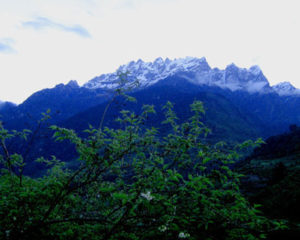
West Sikkim
Something or the other must dominate in this region. The elements have to battle one another. And yet co-exist. Struggle for supremacy from a particular perspective, and harmonise in existence from another. The Teesta will, for instance, roar threateningly through deep gorges, carving out narrow valleys. The slopes here will be steeper than anywhere else in the world. Mountain faces will be sharper than is normally the case and yet be greener than ever imagined. Even in the wrong season.
 The Red Panda, no matter how cuddly and small, will quietly survive the mercurial temperament of nature. As will the Yak, trembling in the snows, still plodding on. Glaciers will rumble forbiddingly. Avalanches will thunder down on them. Yet the peaks will glow, drawing themselves up to their full height, their beauty brazenly establishing the true hierarchy of nature. Snowstorms and white will form one end of the spectrum, while hot weather at lower climes will define the climatic boundaries of the region at the other. The Kangchenjunga will loom above it all, its illusion making a mockery of the reality of Everest.
The Red Panda, no matter how cuddly and small, will quietly survive the mercurial temperament of nature. As will the Yak, trembling in the snows, still plodding on. Glaciers will rumble forbiddingly. Avalanches will thunder down on them. Yet the peaks will glow, drawing themselves up to their full height, their beauty brazenly establishing the true hierarchy of nature. Snowstorms and white will form one end of the spectrum, while hot weather at lower climes will define the climatic boundaries of the region at the other. The Kangchenjunga will loom above it all, its illusion making a mockery of the reality of Everest.
Amazing though it may seem, this whole glory can be savoured on a single trek through West Sikkim. Hugging the razor edged Singalila Ridge, the Himalayan divide between India and Nepal, this much-talked about trek to Dzongri, gets the best of West Sikkim etched indelibly on adventurous minds.
 From the trail head at Yuksom, the erstwhile capital of Sikkim in the velvet green of 5,800 feet, to the high point of Dzongri Top at 15,000 feet, right in the splendour of the Kangchenjunga Sanctuary, the trek passes through thickly forested ridges crowded with rich flora to the heights above the tree line, finally culminating at the breathtaking snowy heights of the Kangchenjunga Sanctuary. An unforgettable panorama of jagged snow peaks cutting across in an arc of 270 degrees through the azure sky. The landscape is incidental. It is the trekker who changes! This is indeed one of the most spectacular treks in the entire Indian Himalayas.
From the trail head at Yuksom, the erstwhile capital of Sikkim in the velvet green of 5,800 feet, to the high point of Dzongri Top at 15,000 feet, right in the splendour of the Kangchenjunga Sanctuary, the trek passes through thickly forested ridges crowded with rich flora to the heights above the tree line, finally culminating at the breathtaking snowy heights of the Kangchenjunga Sanctuary. An unforgettable panorama of jagged snow peaks cutting across in an arc of 270 degrees through the azure sky. The landscape is incidental. It is the trekker who changes! This is indeed one of the most spectacular treks in the entire Indian Himalayas.
Across the main Singalila Ridge lies the Kangchenjunga massif comprising the main peak (8586 m), the central peak (8482 m) and the south peak (8476 m).
To the north beyond Kangchenjunga, the Ridge glitters with the Nepal peak (6910 m), Kirat Chuli (7365 m), Pyramid peak (7123 m), Dome Kang (7442 m), Jongsang (7483 m) and the Lonak peak (6710 m). However, these peaks north of Kangchenjunga are not visible on the trek. It is peaks adjoining and to the south of Kangchenjunga and Talung (7349 m) in the fabulous West Sikkim region that loom close and clear in breathtaking proportions. They include Kabru North (7338 m), Kabru South (7317 m), Kabru Dome (6600 m), Forked peaks I, II, .III and IV (6100, 6000, 5900 and 5500 m), Rahtong (6679 m), Koktang (6147 m), Sangri (5300 m), Rinok (4800 m) and Khang (5560 m).
Two peaks in the region stand out for their unique appearance. The first is Kabur (4800 m) near the Dzongri La, a black peak, sacred to the point that no one is allowed to step on it. The second is clearly the most beautiful peak in the amphitheatre, the Frey peak at 20,000 feet – a training peak for HMI, Darjeeling.
 It pierces through the sky, its pinnacle being the first to catch the morning glow of the sun, shooting out from a huge tapering face of ice and rock. The peaks form an amphitheatre enclosing the formidable Rahtong glacier. However, without getting into the amphitheatre, the best viewpoint of this close panorama, is Dzongri top, rising from the yak pastures of Dzongri.
It pierces through the sky, its pinnacle being the first to catch the morning glow of the sun, shooting out from a huge tapering face of ice and rock. The peaks form an amphitheatre enclosing the formidable Rahtong glacier. However, without getting into the amphitheatre, the best viewpoint of this close panorama, is Dzongri top, rising from the yak pastures of Dzongri.
Dzongri
Stage 1
This is a drive of about 6 to 7 hours from Darjeeling to Yuksom, the erstwhile capital of Sikkim. The road crosses the spectacular gorge enclosing the turbulent Teesta river, over the Coronation Bridge. A lunch break at Jorethang in Sikkim and then onwards to Yuksom via Legship. The route runs through the typical rural landscape of Sikkim with its stepped rice fields and green forests with the Teesta river roaring below. Yuksom has comfortable trekkers’ huts and even at its 5,800 feet altitude, boasts of the first views of Pandim and Kabru peaks.
Stage 2
This is a tough first day trek by any standards, involving a steep walk through thickly forested ridges to Bakhim at 9,000 feet. The Teesta is crossed five times over rope bridges. It is advisable that not more than three people are over the rope bridge at the same time. Leeches and insects are the rule here. A forest rest house and a suitable campsite provide welcome relief on a hard day. From Bakhim, Yuksom is seen far below on the horizon and Tiger Hill of Darjeeling, still valiantly attempts to raise is head before bowing out to the higher altitude. You could try “toomba”, the local liquor, at a little teashop at Bakhim, which is a small settlement with not more than 10 houses.
Stage 3

Mountaineers and very fit trekkers could proceed directly from Bakhim to Dzongri. However, others would much rather stop for the night at Pethang (3650 m), a small grassy campsite with a water source close by, on a side trail. On route, through meadows and forests, the Tibetan settlement of Tsoka (pronounced Choka ) is arrived at. It has, as is typical, a monastery and just a few houses. The trail has magnificent rhododendron forests, with glimpses of snow peaks at Pethang.
Stage 4
A steep Stage reaching the ridgeline separating the Prek valley on one side and the Rahtong valley on the other. Back south are the ridges of Yuksom and to the north rises the Kangchenjunga. To its right and towards the northeast, looms the beautiful peak of Pandim and to the West beyond the Rahtong valley is the imposing Singalila Ridge. Passing by dwarf rhododendrons, the expansive yak pastures of Dzongri are reached. Ranging from 4,000 to 4,700 m, Dzongri is a large slice of the geography of the Tibetan highlands. Comfortable trekkers’ huts are here as well.
Stage 5 or rest day
This involves climbing up to Dzongri top, over fresh brown earth amidst snowflakes and sleet. An amazing panorama of the mighty peaks of West Sikkim rises suddenly and almost encircles Dzongri Top. This is clearly the high point of the trek. Advisable to start early as clouds come in blocking the view by around 11.00 in the morning.
Return stages
Return by the same route. However this time Dzongri to Bakhim could be done in one day with the second day on the trail to Yuksom.
Many other variations of this trek are possible.

Leave a Reply